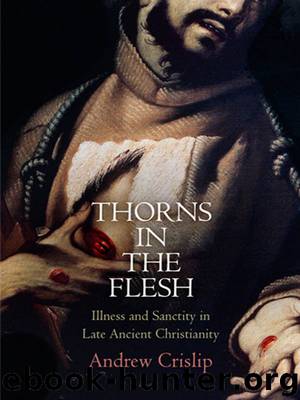Thorns in the Flesh by Crislip Andrew;

Author:Crislip, Andrew;
Language: eng
Format: epub
Publisher: University of Pennsylvania Press
Published: 2013-05-27T16:00:00+00:00
Palamon’s illness evokes Athanasius’s description of Antony in old age, never relenting in his askēsis and yet enjoying perfect health until death at 105. The Great Coptic Life, in contrast, traces Palamon’s affliction of the spleen to his ascetic rigor. His illness furthermore does not signify Satan’s torments (as did Syncletica’s cancer), nor does it result from self-torturing or transgressions of ascetic norms (as we saw variously in Chapter 4). It is a simple function of his asceticism. According to the esteemed doctor, the cure is simple: Palamon must lessen his asceticism, if even only slightly.
In both the Coptic and Greek versions, Palamon takes this advice and eats a diet appropriate for the sick, but failing to see any improvement after a few days (hanehoou), he concludes that the treatment will not work. In the context of ancient medical practice (or modern for that matter) a few days is an extraordinarily short time to expect relief from dietary therapy. The Life rather plainly implies that Palamon simply had no interest in seeing his treatment through. Instead he interpreted his illness as an opportunity to emulate the martyrs of old. “Do not think,” Palamon says, “that recovery (mton) is from perishable foods, but recovery and strength (jom) is from our Lord Jesus Christ. For if the martyrs of Christ endured their limbs to be cut off and were beheaded and burned in the fire, and they endured unto death in the faith in god that is theirs, then I am worthy to be sick (erjōb) because of an insignificant (elakhiston) illness. Although I obeyed you, and was persuaded by you, and ate the foods considered to strengthen the body, look, no relief has come to me.”34 Palamon’s words reflect Paul’s ubiquitous words to the Corinthians, as well as the gendered rhetoric of martyrological narratives; through endurance of sickness or weakness (erjōb) he will gain strength (jom) from Christ.
Yet here again the Life’s interpretation of the meaning of the saint’s illness is conflicted and ambivalent. While the Greek and Coptic traditions diverge at this point, both grapple with a complicating factor: Palamon did not receive the kind of enduring health from Christ that one might expect from such hagiographies as the Lives of Antony and Onnophrius. In the Greek Vita Prima, Palamon boldly predicts, “So if I return to the rigorous askēsis in which is all comfort I will be healed.”35 Palamon’s confidence in asceticism was misplaced, since he was dead a month later.36 The Greek Life’s stark presentation of Palamon’s death leaves the question of meaning unanswered. The Coptic version complicates the matter. Although Palamon declines to continue treatment, gone is Palamon’s bold confidence that he would be cured by his askēsis. Yet in the Coptic he is cured, however briefly: “And thus he returned again to his ascetic practices (nefaskēsis) in great suffering, until the Lord saw the constancy of his strength (ntefmetjōri) and gave him comfort (nteftimton) and healed him (nteftalcof) from his illness.”37 Thus in the Great Coptic
Download
This site does not store any files on its server. We only index and link to content provided by other sites. Please contact the content providers to delete copyright contents if any and email us, we'll remove relevant links or contents immediately.
| Book of Common Prayer | Catechisms |
| Devotionals | Hymns & Hymnals |
| Meditations | Monasticism & Asceticism |
| Pentecostal & Charismatic | Prayerbooks |
| Rites & Ceremonies | Sacraments |
More Language of Letting Go: 366 New Daily Meditations by Melody Beattie(2851)
The Secret Power of Speaking God's Word by Joyce Meyer(2755)
To Light a Sacred Flame by Silver RavenWolf(2680)
How Proust Can Change Your Life by Alain De Botton(2617)
A TIME TO KEEP SILENCE by Patrick Leigh Fermor(1774)
Curse Tablets and Binding Spells from the Ancient World by Gager John G.;(1769)
Anxious for Nothing by Max Lucado(1726)
The Gnostic Gospel of St. Thomas by Tau Malachi(1681)
7 Secrets of Divine Mercy by Vinny Flynn(1620)
365 Tao: Daily Meditations by Ming-Dao Deng(1543)
From Good Goddess to Vestal Virgins: Sex and Category in Roman Religion by Ariadne Staples(1511)
all by Unknown Author(1496)
To Ride a Silver Broomstick by Silver RavenWolf(1477)
Anam Cara by John O'Donohue(1470)
The Fasting Edge by Jentezen Franklin(1454)
To Stir a Magick Cauldron by Silver RavenWolf(1426)
100 Days of Thanks by Thomas Nelson(1408)
The Sacred Enneagram by Christopher L. Heuertz(1377)
New Morning Mercies by Paul David Tripp(1324)
